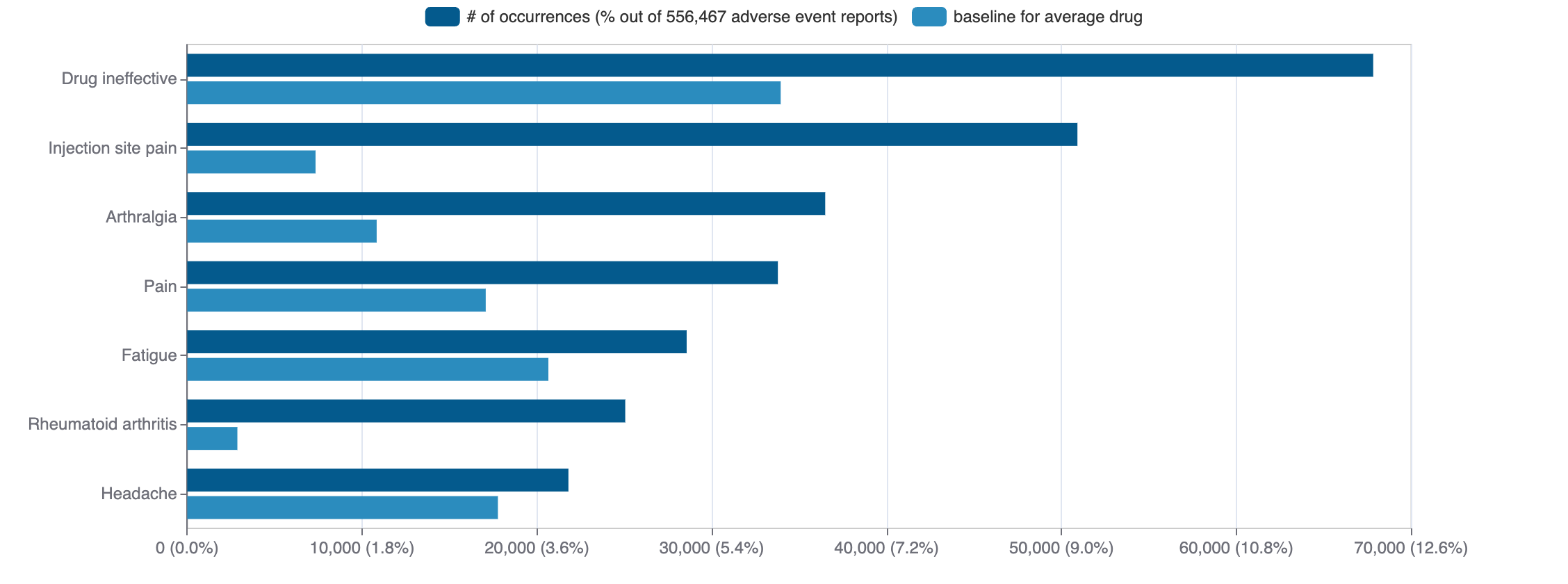Tasmar(tolcapone)
Tasmar (tolcapone) is a small molecule pharmaceutical. Tolcapone was first approved as Tasmar on 1997-08-27. It is used to treat parkinson disease in the USA. It has been approved in Europe to treat parkinson disease. The pharmaceutical is active against catechol O-methyltransferase.
Download report
Favorite
SARS-CoV-2 Interaction
Commercial
Therapeutic Areas
Therapeutic Area | MeSH |
|---|---|
| nervous system diseases | D009422 |
Trade Name
FDA
EMA
Tasmar (generic drugs available since 2015-03-26)
Drug Products
FDA
EMA
New Drug Application (NDA)
New Drug Application (NDA)
Abbreviated New Drug Application (ANDA)
Abbreviated New Drug Application (ANDA)
Tolcapone
Tradename | Company | Number | Date | Products |
|---|---|---|---|---|
| TASMAR | Bausch Health Companies | N-020697 RX | 1998-01-29 | 1 products, RLD, RS |
Show 1 discontinued
Indications
FDA
EMA
Indication | Ontology | MeSH | ICD-10 |
|---|---|---|---|
| parkinson disease | EFO_0002508 | D010300 | G20 |
Agency Specific
FDA
EMA
No data
Patent Expiration
No data
HCPCS
No data
Clinical
Clinical Trials
26 clinical trials
View more details

Mock data
Subscribe for the real data
Subscribe for the real data
Indications Phases 4
Indication | MeSH | Ontology | ICD-10 | Ph 1 | Ph 2 | Ph 3 | Ph 4 | Other | Total |
|---|---|---|---|---|---|---|---|---|---|
| Parkinson disease | D010300 | EFO_0002508 | G20 | — | — | — | 1 | — | 1 |
Indications Phases 3
Indication | MeSH | Ontology | ICD-10 | Ph 1 | Ph 2 | Ph 3 | Ph 4 | Other | Total |
|---|---|---|---|---|---|---|---|---|---|
| Obsessive-compulsive disorder | D009771 | EFO_0004242 | F42 | — | 2 | 1 | — | — | 2 |
Indications Phases 2
Indication | MeSH | Ontology | ICD-10 | Ph 1 | Ph 2 | Ph 3 | Ph 4 | Other | Total |
|---|---|---|---|---|---|---|---|---|---|
| Alcoholism | D000437 | EFO_0003829 | F10.1 | — | 3 | — | — | — | 3 |
| Tobacco use disorder | D014029 | F17 | — | 2 | — | — | 1 | 3 | |
| Traumatic brain injuries | D000070642 | S06 | — | 2 | — | — | — | 2 | |
| Brain injuries | D001930 | S06.9 | — | 2 | — | — | — | 2 | |
| Gambling | D005715 | F63.0 | — | 1 | — | — | 1 | 2 | |
| Impulsive behavior | D007175 | — | 1 | — | — | 1 | 2 | ||
| Schizophrenia | D012559 | EFO_0000692 | F20 | — | 1 | — | — | — | 1 |
| Attention deficit disorder with hyperactivity | D001289 | EFO_0003888 | F90 | — | 1 | — | — | — | 1 |
| Chronic brain injury | D020208 | — | 1 | — | — | — | 1 | ||
| Neurocognitive disorders | D019965 | F09 | — | 1 | — | — | — | 1 |
Show 2 more
Indications Phases 1
Indication | MeSH | Ontology | ICD-10 | Ph 1 | Ph 2 | Ph 3 | Ph 4 | Other | Total |
|---|---|---|---|---|---|---|---|---|---|
| Healthy volunteers/patients | — | 2 | — | — | — | — | 2 | ||
| Amyloidosis | D000686 | EFO_1001875 | E85 | 1 | — | — | — | — | 1 |
| Decision making | D003657 | 1 | — | — | — | — | 1 | ||
| Executive function | D056344 | 1 | — | — | — | — | 1 | ||
| Neuroblastoma | D009447 | EFO_0000621 | 1 | — | — | — | — | 1 | |
| Cocaine-related disorders | D019970 | F14 | 1 | — | — | — | — | 1 |
Epidemiology
Epidemiological information for investigational and approved indications
View more details
Drug
General
| Drug common name | TOLCAPONE |
| INN | tolcapone |
| Description | Tolcapone is benzophenone substituted on one of the phenyl rings at C-3 and C-4 by hydroxy groups and at C-5 by a nitro group, and on the other phenyl ring by a methyl group at C-4. It is an inhibitor of catechol O-methyltransferase. It has a role as an EC 2.1.1.6 (catechol O-methyltransferase) inhibitor and an antiparkinson drug. It is a member of benzophenones, a member of 2-nitrophenols and a member of catechols. |
| Classification | Small molecule |
| Drug class | catechol-O-methyltransferase (COMT) inhibitors |
| Image (chem structure or protein) | |
| Structure (InChI/SMILES or Protein Sequence) | Cc1ccc(C(=O)c2cc(O)c(O)c([N+](=O)[O-])c2)cc1 |
Identifiers
| PDB | 3S68 |
| CAS-ID | 134308-13-7 |
| RxCUI | 72937 |
| ChEMBL ID | CHEMBL1324 |
| ChEBI ID | 63630 |
| PubChem CID | 4659569 |
| DrugBank | DB00323 |
| UNII ID | CIF6334OLY (ChemIDplus, GSRS) |
Target
Agency Approved
Alternate
No data
Variants
Clinical Variant
No data
Financial
No data
Trends
PubMed Central
Top Terms for Disease or Syndrome:

Mock data
Subscribe for the real data
Subscribe for the real data
Additional graphs summarizing 1,457 documents
View more details
Safety
Black-box Warning
Black-box warning for: Tasmar, Tolcapone
Adverse Events
Top Adverse Reactions

Mock data
Subscribe for the real data
Subscribe for the real data
100,387 adverse events reported
View more details
Premium feature
Learn more about premium features at pharmakb.com
Learn more
